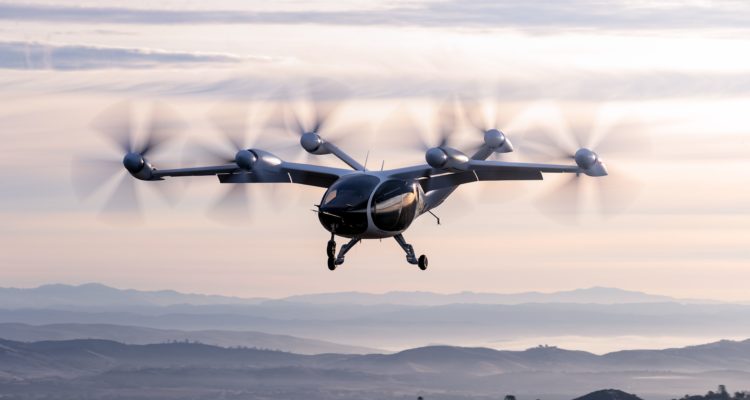The crux for eVTOL aircraft manufacturers is hitting on the right combination of materials, production tooling and automated processes. “We can do all this with engineered materials, but it’s very nuanced,” says Bihlman. “It takes a while.”
One Company’s Path
One company striving to find that right combination is Joby Aviation, which has set an ambitious goal of launching an air taxi service in 2024. Its pre-production prototype began flight testing in 2019 and logged more than 5,300 miles last year. A second prototype received FAA Special Airworthiness Certification for experimental research and development in late 2021. It also earned U.S. Air Force airworthiness approval, allowing the company to fly its aircraft as an Agility Prime contractor.
Joby’s prototypes incorporate high-end thermoset composite materials throughout the vehicle structure, propulsion systems and interior components. The company used conventional manufacturing processes for the prototypes, including hand lay-up and autoclave curing, and has added two automated fiber placement machines to help support pilot plant volumes.
In 2019, Toyota invested $394 million in Joby Aviation and began sharing expertise on high-volume production.
“Toyota’s investment has allowed us to work closely on manufacturing and engineering processes, from the design of tools to the layout of our production facility,” says Walker-Jones. The automaker also worked alongside Joby to design a 580,000-square-foot pilot production facility in Marina, Calif., that it plans to open in two phases.
Joby began its FAA certification program in 2018 when it applied for type certification, which it hopes to complete in 2023. In March, the company moved closer to that goal when it submitted its first area-specific certification plan to the FAA. The plan details the design reports, analysis and testing Joby will employ to demonstrate compliance with FAA safety standards in one functional area of the aircraft – cabin safety.
It Takes Teamwork
The technical prowess, time and resources required to develop, certify and commercialize an eVTOL necessitate collaboration. In addition to Toyota, Joby Aviation partners with Uber, Toray Advanced Composites, Garmin and others. The Agility Prime program was structured to foster relationships with academia, industry and investors.
“The traditional government procurement process is requirements driven, while Agility Prime attempts to turn this model on its head,” says Jensen. “We don’t have a requirement for these new vehicles being built, but we think they could be useful. So, we’re going to help advanced air mobility succeed commercially, then come back on the back end and do procurement.”
The Air Force can provide corporate partners with capabilities such as wind tunnels, acoustic testing and flight test planning, as well as expertise in areas such as computational fluid dynamics. It has awarded more than $100 million in contracts and a handful of companies have earned military worthiness, including Joby, BETA Technologies and Kittyhawk. More contracts and certifications are sure to come.
“We didn’t specify a sunset for this,” says Jensen. “Agility Prime is now a program of record, and we are taking new applications on a rolling basis as companies start to mature and fly.”
While the Air Force has no immediate plans for eVTOL vehicles, a study it conducted with MIT indicated where the new aircraft would complement the military branch’s portfolio of capabilities.
“We don’t anticipate they will operate in highly contested environments,” says Jensen. “But there’s a lot that eVTOL aircraft can do in terms of logistical support and movement of personnel in uncontested areas or ship-to-shore transport.”
Early Applications for eVTOLs
Despite the challenges to implementation, the advanced air mobility market is generating a lot of enthusiasm, as well as speculation over when the first vehicles will take flight and in what capacity.
“It’s incredibly exciting and in some ways a little unnerving,” says Sherman. “But I’m confident that teams are pulling together – and pulling in the same direction – trying to achieve a 2024 commercial introduction of air taxis.” He suspects that air taxi service will be limited at the outset. Jensen agrees.
“I don’t think there will be thousands of air taxis swarming around cities – at least not initially,” he says. Jensen cites the prohibitive cost per mile for air taxi commuting and hurdles with insuring eVTOL aircraft as primary inhibitors to near-term adoption. However, he and Sherman both envision other potential early applications, such as cargo and medical transport.
“If you could put a first responder in a single-seat eVTOL with some drugs and an automatic external defibrillator to respond to cardiac arrest cases where time is everything, you could save tens of thousands of lives a year,” says Jensen, citing a study from MIT.
Bihlman shares Jensen’s conservative stance on AAM, envisioning commercial introduction between 2028 and 2030. In addition to vehicle development, the accompanying infrastructure to support eVTOL aircraft must be created. But he doesn’t want to discourage innovators, adding, “The AAM market will happen.”
Suppliers and manufacturers need to be prepared.
“Being proactive in getting materials and production certified will be key,” says Sherman. “The companies that can show that are going to have the most orders to start with.”
Susan Keen Flynn is managing editor of Composites Manufacturing magazine. Email comments to sflynn@keenconcepts.net.


